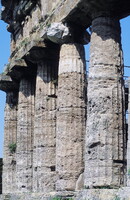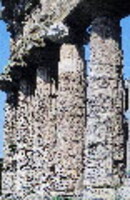| dc.coverage.spatial | Site: Pesto, Campania, Italy | en_US |
| dc.coverage.temporal | 6th-5th century BCE (inclusive) | en_US |
| dc.creator | unknown (Greek (ancient)) | en_US |
| dc.date | -599--400 | en_US |
| dc.date.accessioned | 2013-05-22T19:41:41Z | |
| dc.date.available | 2013-05-22T19:41:41Z | |
| dc.date.issued | -599--400 | en_US |
| dc.identifier | 221030 | en_US |
| dc.identifier.other | archrefid: 480 | en_US |
| dc.identifier.uri | http://hdl.handle.net/1721.3/128954 | |
| dc.description | The Temple of Neptune, tight view of the columns, west portico; Ancient city was established by Greek colonists from Sybaris, who called it Poseidonia; taken by Lucanians 5th cen. BCE & by Romans 273 BCE; was famous for its roses; was destroyed by Saracens 871 AD; now site of the village of Pesto. Source: Thesaurus of Geographic Names (Notes) [website]; http://www.getty.edu/research/conducting_research/vocabularies/tgn/ (accessed 2/14/2008) | en_US |
| dc.format.medium | tufa (originally covered with stucco and painted) | en_US |
| dc.rights | © Scott Gilchrist, Archivision, Inc. | en_US |
| dc.subject | Archaic (Greek) | en_US |
| dc.title | Paestum [site] | en_US |
| dc.type | image | en_US |
| dc.rights.access | Licensed for educational and research use by the MIT community only | en_US |
| dc.identifier.vendorcode | 1A3-G-P-P-C5 | en_US |
| vra.culturalContext | Greek (ancient) | en_US |
| vra.technique | construction (assembling) | en_US |
| vra.worktype | excavation (site) | en_US |
| dc.contributor.display | unknown (Greek (ancient)) | en_US |


